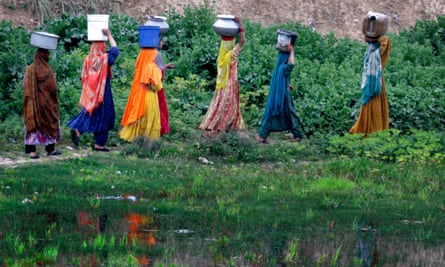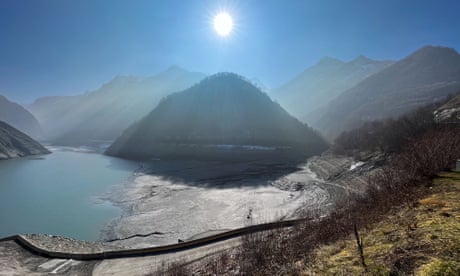Global water crisis leaves half of world food production at risk in next 25 years
Published on by Water Network Research, Official research team of The Water Network in Academic
More than half the world’s food production will be at risk of failure within the next 25 years as a rapidly accelerating water crisis grips the planet, unless urgent action is taken to conserve water resources and end the destruction of the ecosystems on which our fresh water depends, experts have warned in a landmark review.
Half the world’s population already faces water scarcity, and that number is set to rise as the climate crisis worsens, according to a report from the Global Commission on the Economics of Water published on Thursday.
Demand for fresh water will outstrip supply by 40% by the end of the decade, because the world’s water systems are being put under “unprecedented stress”, the report found.
The commission found that governments and experts have vastly underestimated the amount of water needed for people to have decent lives. While 50 to 100 litres a day are required for each person’s health and hygiene, in fact people require about 4,000 litres a day in order to have adequate nutrition and a dignified life. For most regions, that volume cannot be achieved locally, so people are dependent on trade – in food, clothing and consumer goods – to meet their needs.
Some countries benefit more than others from “green water”, which is soil moisture that is necessary for food production, as opposed to “blue water” from rivers and lakes. The report found that water moves around the world in “atmospheric rivers” which transport moisture from one region to another.
About half the world’s rainfall over land comes from healthy vegetation in ecosystems that transpires water back into the atmosphere and generates clouds that then move downwind. China and Russia are the main beneficiaries of these “atmospheric river” systems, while India and Brazil are the major exporters, as their landmass supports the flow of green water to other regions. Between 40% and 60% of the source of fresh water rainfall is generated from neighbouring land use.
“The Chinese economy depends on sustainable forest management in Ukraine, Kazakhstan and the Baltic region,” said Prof Johan Rockström, the director of the Potsdam Institute for Climate Impact Research and one of the co-chairs of the commission. “You can make the same case for Brazil supplying fresh water to Argentina. This interconnectedness just shows that we have to place fresh water in the global economy as a global common good.”
Tharman Shanmugaratnam, the president of Singapore and a co-chair of the commission, said countries must start cooperating on the management of water resources before it was too late.
“We have to think radically about how we are going to preserve the sources of fresh water, how we are going to use it far more efficiently, and how we are going to be able to have access to fresh water available to every community, including the vulnerable – in other words, how we preserve equity [between rich and poor],” Shanmugaratnam said.
Global fresh water demand will outstrip supply by 40% by 2030, say experts
The Global Commission on the Economics of Water was set up by the Netherlands in 2022, drawing on the work of dozens of leading scientists and economists, to form a comprehensive view of the state of global hydrological systems and how they are managed. Its 194-page report is the biggest global study to examine all aspects of the water crisis and suggest remedies for policymakers.
The findings were surprisingly stark, said Rockström. “Water is victim number one of the [climate crisis], the environmental changes we see now aggregating at the global level, putting the entire stability of earth’s systems at risk,” he told the Guardian. “[The climate crisis] manifests itself first and foremost in droughts and floods. When you think of heatwaves and fires, the really hard impacts are via moisture – in the case of fires, [global heating] first dries out landscapes so that they burn.”
Every 1C increase in global temperatures adds another 7% of moisture to the atmosphere, which has the effect of “powering up” the hydrological cycle far more than would happen under normal variations. The destruction of nature is also further fuelling the crisis, because cutting down forests and draining wetlands disrupts the hydrological cycle that depends on transpiration from trees and the storage of water in soils.
Harmful subsidies are also distorting the world’s water systems, and must be addressed as a priority, the experts found. More than $700bn (£540bn) of subsidies each year go to agriculture, and a high proportion of these are misdirected, encouraging farmers to use more water than they need for irrigation or in wasteful practices.
Industry also benefits – about 80% of the wastewater used by industries around the world is not recycled.
Ngozi Okonjo-Iweala, the director general of the World Trade Organization, also a co-chair of the commission, said countries must redirect the subsidies, axing harmful ones while ensuring poor people were not disadvantaged. “We must have a basket of policy tools working together if we are to get the three Es – efficiency, equity and environmental sustainability and justice. Therefore we have to couple the pricing of water with appropriate subsidies,” she said.
At present, subsidies mainly benefit those who are better off, Okonjo-Iweala added. “Industry is getting a lot of the subsidy, and richer people. So what we need are better targeted subsidies. We need to identify the poor people who really need this,” she said.

The water crisis has an outsized impact on women, one of the commission’s co-chairs said. Photograph: Anjum Naveed/AP
Attached link
https://www.theguardian.com/environment/2024/oct/16/global-water-crisis-food-production-at-riskTaxonomy
- Food & Beverage
- Food Security
